
|   |

|   |
Sculpting the woman - Padma Jayaraj, Thrissur e-mail: padmajayaraj@gmail.com March 5, 2012 A sculpture, for a proper understanding, needs to be viewed from nine angles of perception. The sculpture that the Kathaakar team presented was viewed from the angle of nine basic emotions, the navarasas. Stree - Rupa/Aparupa is a peep into the persona of the woman, both what is obvious and what is hidden, what is gracious and what is intriguing. An analysis of the psychological mystery of the woman is carried through the narration and dramatization of known events in the lives of mythical and historical figures of India. For the Kathak trio, Apoorva Wadke Bakhsh, Leena Malakar Vij and Molina Singh, the Kathak mode of dance was just a format to tell tales: tales that are laudable, ignoble, baffling, human, and superhuman. The innovative dance design may be the byproduct of a need to present Kathak without its most important ingredient, its very special orchestra that brings out the soul and spirit of the dance form, its competition between tabla bols and the rhythm of footwork. Travelling to distant places with a number of artistes may not be economically feasible. Dancing to recorded music, the team highlighted an unusual performance in a praiseworthy manner. The presentation as well as the theme was commendable. Stree – Rupa / Aparupa was presented in Thrissur in connection with Sivarathri Festival at the temple precincts of Sree Vadakkunathan. The woman has always intrigued man. In India, she has been either worshipped or killed. The nine aspects of the woman presented in this piece range between these two points. The dance recital starts with Molina Singh as Mohini, the charmer who fooled the arrogant Bhasmasura. Lord Siva showed no discrimination in bestowing boons. With the power of destruction, Bhasmasura becomes a fool, the hasya incarnate. Siva blessed Bhasmasura only to be destroyed by him. It’s the familiar tale, told in all art forms. The enchantress feigns sringara just to make a fool of him. In an amusing performance the enchantress charms the spectators as well. It gives the subtle hint that man has been a toy in her hand. In a classic case of tilting scales, here is the story of Man proposing and Woman disposing choreographed and performed by Molina Singh to her own musical composition. 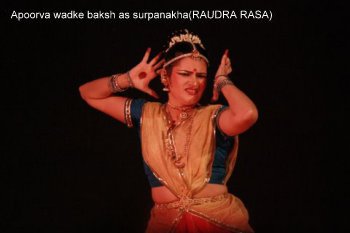 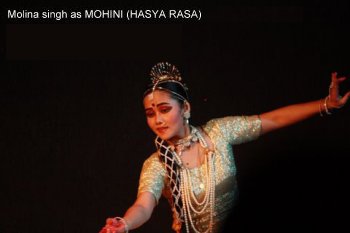 Soorpanakha is the embodiment of deceit in Ramayana. Her real nature is hidden underneath her mask of beauty when she comes to woo the handsome princes. When she fails in rousing Rama and later Lakshman, her innate roopa comes out in the open. The dramatic turn of events give rise to the special flavor of raudra, the anger of a demon, superhuman in dimension. Apoorva presented the strength and power of a mythical character giving importance to abhinaya, to the music composed by Manoj Desai. Sringara has been the weapon that killed many a man in human stories. Menaka, divine in element, tamer of the sage Viswamitra, destroyer of the power of years of thapasya, is the classic charmer with her tool sringara. Menaka in the enchanted forest land of lyrical beauty, flowing rivulets, flowering trees and love birds, trying to provoke the sage is a charming love scene. Choreographed and performed by Leena Malakar to the musical score of Manoj Desai, Menaka remains visually etched in Kathak design. Gandhari, choreographed and presented by Molina Singh, was a surprise indeed. Gandhari, the wife of Dhritarastra blindfolded herself to remain a pathivritha. The cries of Gandhari, the archetypal mother who lost her sons have echoed in the battle fields ever since Kurukshetra. In the dance recital, Molina Singh projects the hidden facet of the woman who lived to be the queen. In a stunning theatrical performance regulated by her musical composition, only one emotion, bhibatsa (revulsion) is displayed in great intensity. The pregnant queen devastated by the news of the birth of a son to Kunthi, is in a towering rage. Like burning fire, her anger induces labor pains. Convoluted in self-induced birth pangs, she delivers a lump of flesh. The writhing labor pangs on the stage in special costume highlighted the drama. Disgusted at the sight of the mass of flesh that she delivered, she throws it away in repulsion. Gandhari, in her costume of blood red and black emerges a part of dramatis persona rather than the usual Kathak dancer. 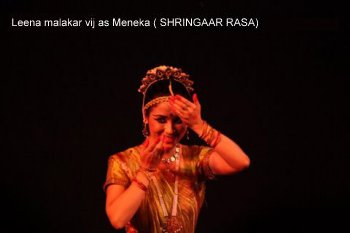 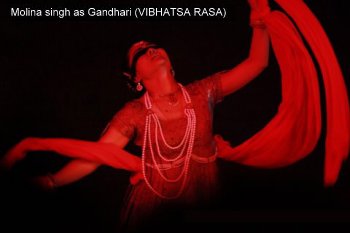 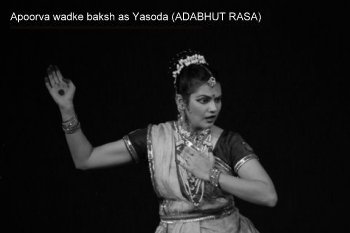 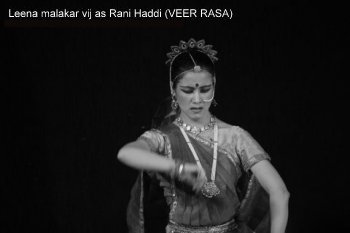 The orchestration of the rasas reaches its peak in Gandhari that Yasoda comes as a welcome relief. Once again, Apoorva presents a curious angle to view Yasoda, the indulgent foster mother of Krishna who has spoilt her naughty darling. For Yasoda, the boy who killed the serpent Kaliya, who lifted the mountain Govardhan, evoked only wonder. It is the sense of wonder evoked by her lovable rascal of a son that makes Yasoda such an indulgent mother. Indeed the culminating point is when she asks him to open his mouth to test whether he has eaten mud -Viswaroopa darsan! What emotion should it bring, other than adbhuta! A beautiful recital of the celebrated mother-son relationship drenched in vatsalya set to music by Manoj Desai stole the heart of Krishna lovers in Thrissur. The Rajput clan has special place in Indian history. Made of brave mettle, the Rajput women have evoked admiration for their bravery and sacrifice. The story of Rani Haddi married to the chieftain of Mewar is rather unknown in Kerala. The gory tale of presenting her head as a memento to rouse her husband to the battlefield sounds bizarre to today’s audience. But such were the women who made history for us in India. Choreographed and performed by Leena Malakar to the music composed by Molina Singh brings to light veera as the basic emotion although Sringara was quite fascinating in the scenes of conjugal bliss. Karuna rasa, the core value of Buddhist philosophy is epitomized in none other than Yasodara, the wife of Siddhartha. Renounced by her husband, Yasodara follows the path of the Buddha, renounces worldly pleasures but remains duty bound to rule the kingdom for their son, a true karma yogini. As she lets the bird out of the cage, out of her hand to skyward, the theme of liberation is suggested as the undercurrent of her story. The technique of bringing sakhi on the stage proved singular for dramatization. Yasodara, choreographed and executed by Apoorva set to the scores of Manoj Desai is the most dignified lady in the trajectory that the persona of the Indian woman has left behind.   Kali is another character that is defined by aharaya. In an experimental mode, quick-paced thandava dance, black costume, and music close to chanting, sculpt Kaali, the Goddess of Death in awesome ferocity. In the hearts of the ignorant mortals she plants fear. Choreographed and performed by Molina Singh set to her own musical composition, Kali emerges as a power enveloped in bhayanaka rasa, which negates everything that life offers. Santha, peace, is the boon of Nature. Life giving, life sustaining water has brought civilization, culture and peace to humans. A group performance set against the music of waters, the last item heightened the symbolic. Once again, aharaya plays a role in this experimental piece. Clouds gather, raindrops fall in rhythmic beat, growing in intensity, rivulets grow into rivers and flooding and flowing seaward merge in the oceans. Our philosophy was born from the realization of the eternal cycle of life. And peace is born from its acceptance. In a lyrical performance set against the orchestra of the waters, the audience experienced peace, santhi, the peace that passeth understanding. Padma Jayaraj is a freelance writer and a regular contributor to www.narthaki.com |